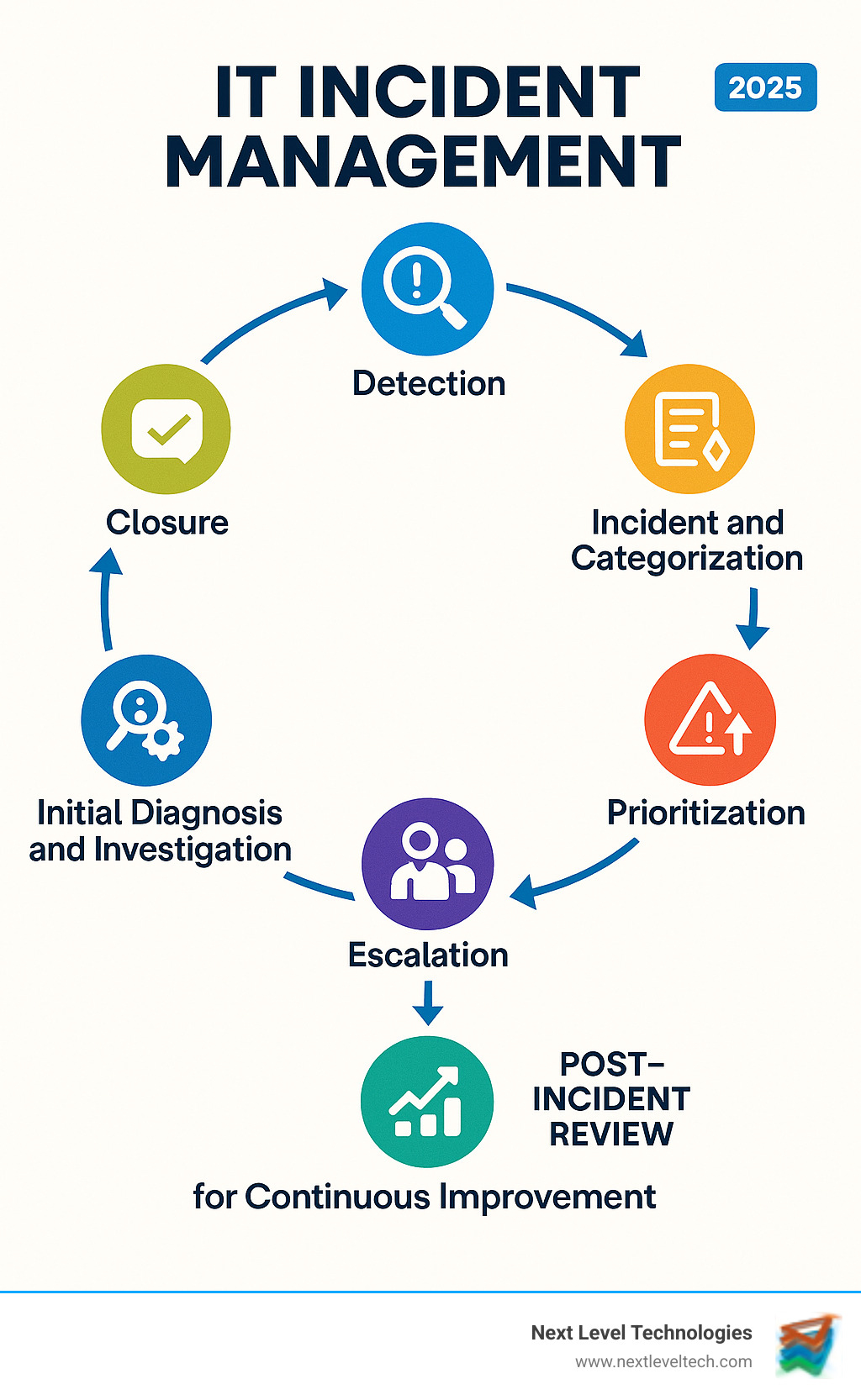Incident Management: Keeping Your IT Services Running Smoothly
September 10, 2025

Unlock the power of Data analytics healthcare. Explore applications, benefits, and career paths to transform patient care and operations.
December 11, 2025

Unlock SMB growth! Discover essential IT solutions for SMBs to master cybersecurity, optimize infrastructure, and boost productivity.
December 10, 2025

Unlock data potential with Managed data services. Reduce costs, boost security & expertise. Focus on growth, not data headaches!
December 9, 2025
September 10, 2025
IT incident management is the structured process organizations use to handle unplanned IT service disruptions. When your email server crashes or a critical application fails, this process gets your business back up and running with minimal impact.
Quick Definition:
The stakes are incredibly high. When technology fails, businesses suffer immediate consequences. 41% of mid-size and large companies report losses from $1 million to $5 million per hour during system outages. A solid incident management process is essential for survival.
Every minute of downtime means:
Without proper incident management, a quick fix can spiral into a major disruption. With the right processes and team, you can detect issues faster, respond effectively, and restore service before significant damage occurs.
I'm Steve Payerle, President of Next Level Technologies. Since 2009, I've helped businesses in Columbus, Ohio, and Charleston, WV, build robust IT incident management capabilities. I've seen how a structured approach transforms chaotic emergencies into manageable processes.

At its heart, IT incident management is about getting things back to normal, fast. It's the systematic way IT teams respond to an unplanned event—like a server crash or application freeze—that threatens your service quality. The main goal is to quickly restore essential services, minimize disruptions, and keep your business running smoothly.
This process is a cornerstone of IT Service Management (ITSM). While reactive, it provides invaluable insights that help prevent future issues, boosting user satisfaction and business stability. Learn more in our comprehensive ITSM Guide.
To master IT incident management, it's crucial to understand the difference between an incident, a problem, and a service request. Each requires a unique approach.
| Category | Focus | Goal | Timing |
|---|---|---|---|
| Incident | An unplanned event causing service disruption | Restore normal service operation as quickly as possible | Reactive |
| Problem | The underlying root cause of one or more incidents | Identify and resolve the root cause to prevent recurrence | Proactive |
| Service Request | A standard user request for information or access | Fulfill the request efficiently according to predefined procedures | Reactive |
An incident is an unplanned interruption, like a user's laptop crashing or a Wi-Fi outage. The immediate goal is to restore service as quickly as possible.
A problem is the root cause of one or more incidents. If a system repeatedly crashes, our expert team, with their extensive technical know-how and cybersecurity training, investigates to find and fix the deeper issue to prevent it from happening again. Explore this further in our video on problem management.
A service request is a standard, routine request from a user, such as a password reset or a request for new software. These are not disruptions and are handled by our IT help desk professionals through standard procedures.
The ultimate purpose of IT incident management is to get your services back to normal, fast. When IT services are down, your employees can't work, customers are impacted, and your bottom line suffers. Minimizing costly downtime is paramount.
Our primary objective is to restore normal service operation as quickly as possible, maintaining service availability and quality. A key part of this is meeting your Service Level Agreements (SLAs), which define the level of service we're committed to providing.
Metrics like Mean Time To Resolution (MTTR) are critical. This measures how quickly we resolve an incident from start to finish. Faster resolution times align with your SLAs, leading to a better customer experience and more satisfied employees.
The Information Technology Infrastructure Library (ITIL) framework is the gold standard for IT incident management. It provides a collection of best practices that transform chaotic emergency responses into smooth, predictable processes. ITIL offers a process-driven approach that takes the guesswork out of incident response, helping teams restore normal service operation quickly while minimizing business impact.

ITIL 4, the latest version, is flexible, allowing organizations to tailor their approach. At Next Level Technologies, our team's extensive cybersecurity training and technical experience allow us to implement ITIL frameworks that improve response times and provide data for continuous improvement.
ITIL maps out the incident journey in seven clear stages to ensure nothing is missed:
Smart IT incident management uses a prioritization system to separate the urgent from the inconvenient. The ITIL priority matrix combines Impact (how much damage is caused) and Urgency (how quickly it needs a fix).

This matrix ensures business-critical issues get the immediate attention they deserve. Understanding how a priority matrix works can dramatically improve your organization's response effectiveness.
Effective IT incident management requires the right people equipped with the right tools, all working together seamlessly. This combination of collaboration, efficiency, and proactive monitoring is crucial for minimizing downtime.
A successful incident management operation relies on clear roles. While titles vary, these are the core functions:
At Next Level Technologies, our teams in Columbus, Ohio, and Charleston, WV, have staff with extensive cybersecurity training and technical expertise across all these levels, ready to handle any incident. Learn more about our approach to IT Security Incident Management.
Modern IT incident management demands a robust toolkit to support every stage of the lifecycle.

These tools, especially those with workflow automation, are vital for efficient operations.
During an IT outage, communication is the glue that holds the response together. It manages expectations, builds trust, and ensures a coordinated effort.
A proactive communication plan is a best practice, outlining who communicates what and when, ensuring information flows smoothly during a crisis.
Implementing a structured IT incident management process builds a more resilient, efficient, and user-friendly IT environment. The benefits extend far beyond just fixing things; it's an investment in your business's stability and growth.
Key advantages include:
Successful IT incident management shines when you adopt core best practices. These principles guide our expert teams in Columbus, Ohio and Charleston, WV.
While IT incident management is a core part of traditional ITSM, modern approaches have emerged.
These approaches often overlap, but the universal goal remains: minimize downtime and restore service rapidly. At Next Level Technologies, we integrate the best aspects of these methodologies to provide an adaptable incident management service custom to our clients' needs.
After helping businesses in Columbus, Ohio and Charleston, WV manage IT incidents for over a decade, I've heard many questions. Here are the most common ones to clarify key concepts.
The primary goal is to restore normal IT service operation as quickly as possible after an unplanned disruption. The focus is on minimizing the negative impact on business operations and maintaining the highest possible levels of service quality and availability.
When your systems are down, every minute counts. IT incident management is about getting your business back up and running so you can serve customers and keep operations moving.
This is about symptoms versus causes.
An incident is a single, unplanned event causing a service disruption (the symptom). For example, a server is down. Incident management focuses on a quick fix or workaround to restore service.
A problem is the underlying root cause of one or more incidents (the disease). For example, a faulty network card is causing the server to crash repeatedly. Problem management seeks a permanent solution to prevent recurrence.
Our staff, with their extensive technical experience, are skilled at distinguishing between incidents needing immediate fixes and problems requiring deeper investigation.
A major incident is a high-impact, high-urgency incident that causes significant disruption to business-critical services. It affects a large number of users, threatens substantial financial loss, or halts critical business operations.
Examples include a company-wide network outage or the failure of a core business application. These situations demand a swift, coordinated response from a dedicated team, often with leadership involvement and special procedures. Our staff, with extensive cybersecurity training, are prepared to mobilize immediately for these critical events. The goal is the same—restore service fast—but the scale and urgency require a much more intensive response.
In today's digital-first world, a solid IT incident management process is essential for business survival. When systems fail, the difference between a minor hiccup and a major disaster is your preparation.
Every minute of downtime costs money, frustrates customers, and damages your reputation. A structured process transforms chaos into a controlled, efficient recovery. The result is reduced downtime, improved stability, and genuine business resilience.
At Next Level Technologies, our teams in Columbus, Ohio and Charleston, WV bring years of technical experience and extensive cybersecurity training to help you build systems that prevent problems, not just fix them. We tailor our incident management approach to fit your unique needs.
Don't wait for the next IT emergency. Build resilience now. Ready to transform your IT from reactive firefighting to proactive protection?
Unlock the power of Data analytics healthcare. Explore applications, benefits, and career paths to transform patient care and operations.
December 11, 2025
Unlock SMB growth! Discover essential IT solutions for SMBs to master cybersecurity, optimize infrastructure, and boost productivity.
December 10, 2025
Next Level Technologies was founded to provide a better alternative to traditional computer repair and ‘break/fix’ services. Headquartered in Columbus, Ohio since 2009, the company has been helping it’s clients transform their organizations through smart, efficient, and surprisingly cost-effective IT solutions.
